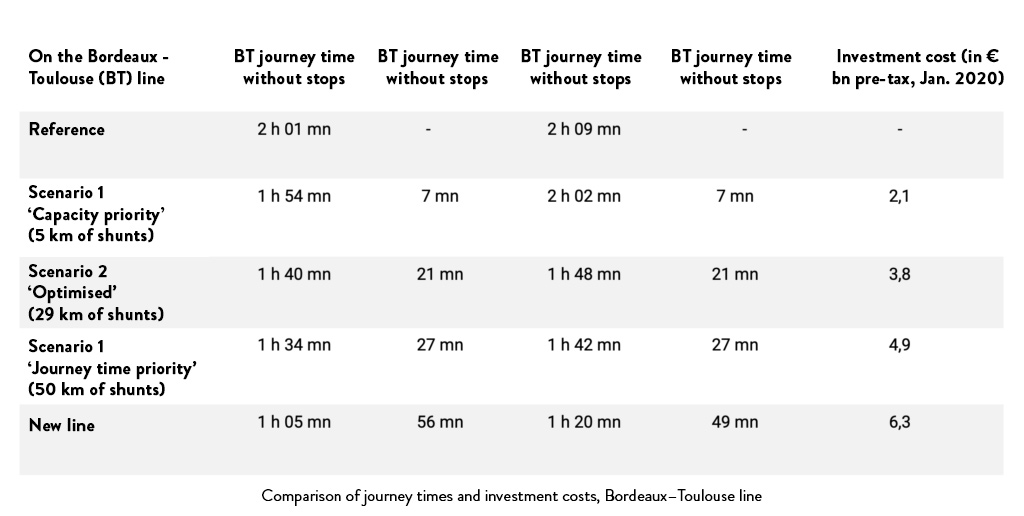Can you increase speed and capacity on conventional lines?
Going from 160 to 220 km/h would require major upgrades to existing lines.
The costs could then exceed those of building a new line in terms of impact and amount.
The characteristics of the existing Bordeaux–Toulouse line (with its many curves, level crossings and around twenty villages) mean that that it is not possible to increase train speeds without major upgrades. On the current route, modernising the line would save less than 10 minutes.
By comparison, the new line would save between 49 and 56 minutes (with and without stops).
To save more time by upgrading the line, it would be necessary to modify the curves of the line, sometimes in very densely populated urban areas, or to build bypasses around built-up areas and sections of new line (shunts). Other capacity improvements (upgrading to three or four tracks) are also needed to accommodate the growth of suburban traffic around the cities of Bordeaux and Toulouse. The scenarios for the modernisation of the line show that the investment costs are very high with a time saving of between seven and 27 minutes.
On the Bordeaux–Hendaye line, an increase in speed to 220 km/h on the existing line would result in a time saving to Dax that is close to that of the new line project (a saving of 15 minutes for the modernisation scenarios compared with 20 minutes for a new line). However, the capacity of the line must also be taken into account, particularly in view of the development of trans-Pyrenean freight traffic. Trains will not be able to run at full speed because of the presence of slower trains ahead, and trains cannot overtake each other on the current line.
Further details
On the existing Bordeaux–Toulouse line, the modernisation scenarios examined show that the investment costs are very high with a time saving of between seven and 27 minutes.

Lower performance on existing lines
The diagram below shows the speed curves for a high-speed train (TGV) travelling down from Bordeaux to Toulouse, in the reference case and in scenario 3, ‘journey time priority.’ A speed of 220 km/h is reached in three main zones, over a cumulative distance of 180 km. However, the performance is much lower than with a new line from start to finish.

In 2016, the French Federation of Passengers’ Associations (FNAUT) carried out a study entitled ‘Widespread use of 200–220 km/h on the main conventional lines: realistic or utopian?’ On the Bordeaux–Toulouse line, the study estimates possible reductions in journey time (excluding capacity issues) of nine minutes without any changes to the line, or 15 minutes with the redesign of 14 curves. The report concludes that “it is unrealistic to think that upgrading conventional lines to 200 km/h would provide a level of service close to that of high-speed lines.”
Capacity on the Bordeaux–Hendaye line
On the Bordeaux–Hendaye line, increasing the speed to 220 km/h on the existing line would result in a time saving to Dax that is close to that of the new line project (a saving of 15 minutes for the modernisation scenarios compared with 20 minutes for a new line). The limited difference is due to the geometric characteristics of the existing line and the decision to share the new line with Bordeaux–Toulouse (common trunk). However, the capacity challenges are also considerable, particularly in view of the development of trans-Pyrenean freight traffic.
In a few years’ time, the Spanish network will be connected in Irun/Hendaye (with the installation of a third rail on the existing line on the Spanish side and the opening of the new ‘Basque Y’ lines to San Sebastián in 2028). This link will allow the development of new rail services in the Atlantic Corridor, with the aim of increasing the modal share of rail.
